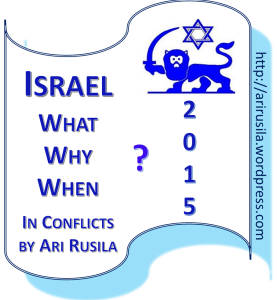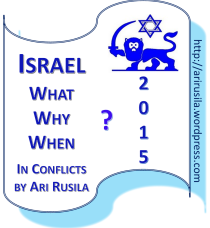 WWW Israel 2015 is a review about my articles related to Israel published in Conflicts by Ari Rusila website. Review is not a complete description about what, why and when happened in Israel all the year 2015 but a discourse about issues highlighted in this particular site.
WWW Israel 2015 is a review about my articles related to Israel published in Conflicts by Ari Rusila website. Review is not a complete description about what, why and when happened in Israel all the year 2015 but a discourse about issues highlighted in this particular site.
The main themes were Gaza and possible Hamas-Israel deal and seeking for solutions to Israeli-Palestinian conflict. The main article in my opinion was analysis of that [Analysis: Resolving The Israeli-Palestinian Conflict ]. Other topics were i.a Knesset elections, antisemitism, Iran and Susya. In addition two historical articles were published.
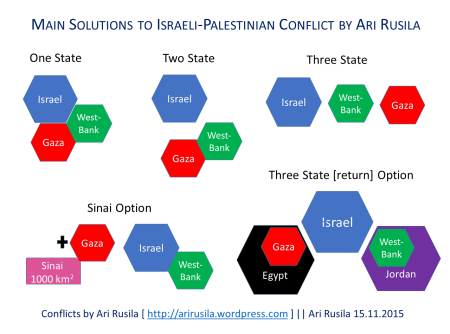
Gaza and Hamas-Israel Deal
In April 30, 2015 it was reported, that official representatives of the Israeli government and defense establishment have been holding a real dialog with the Islamic terrorist group – Hamas – in a bid to reach a long-term calm on the Gaza border. These secret talks have been “partly direct” and partly through Qatari and European mediators.
 It might be that the international community must define their two-state solution with new content including two Palestinian state – one Islamist emirate in the Gaza Strip and an other Fatah-controlled state in the West Bank. Related to possible deal between Hamas and Israel there is a risk that internal disagreements between Hamas’ political and military wings could endanger it. Ezzedeen Al-Qassam Brigades might take advantage of instability within the Hamas to carry out attacks on the border with Israel without getting a green light from Hamas’ political leaders. Struggle inside Hamas is not the only battlefield in Gaza. A group calling itself Supporters of the Islamic State in Jerusalem has continued to challenge the Gaza-ruling Palestinian entity Hamas. More in What’s Going On In Gaza (And Mideast Peace) and Gaza State Under Construction, West Bank Remains Bystander
It might be that the international community must define their two-state solution with new content including two Palestinian state – one Islamist emirate in the Gaza Strip and an other Fatah-controlled state in the West Bank. Related to possible deal between Hamas and Israel there is a risk that internal disagreements between Hamas’ political and military wings could endanger it. Ezzedeen Al-Qassam Brigades might take advantage of instability within the Hamas to carry out attacks on the border with Israel without getting a green light from Hamas’ political leaders. Struggle inside Hamas is not the only battlefield in Gaza. A group calling itself Supporters of the Islamic State in Jerusalem has continued to challenge the Gaza-ruling Palestinian entity Hamas. More in What’s Going On In Gaza (And Mideast Peace) and Gaza State Under Construction, West Bank Remains Bystander
In July 2015 the Shin Bet [aka The Israel Security Agency/ISA aka Shabak] with Israeli Police arrested a Hamas operative Ibrahim Adel Shehadeh Shaer – a tunnel digger in the group’s armed wing. According Israel Hayom the man was detained for questioning and he proceeded to provide interrogators with valuable information about the terrorist organization’s extensive digging plans and the location of new tunnel access points. Shaer also told interrogators that to sustain its military infrastructure, Hamas diverts resources and materials delivered to Gaza within the framework of rehabilitation efforts. Slow reconstruction activities in Gaza is nothing new nor the fact that donor aid for reconstruction is misused e.g. for tunnels. This aspect was very well highlighted by Dr. Ibrahim Abrashin – ex-minister representing political wing in Hamas – in his recent article (more in Palestinians: A Rare Voice of Sanity ). A wider picture about non-existent skills of Palestinian authority to deliver international donor aid to beneficiaries one can find from my article Palestine – Placebo effect for people and society with 20 bn bucks . More in Instead of Gaza’s Reconstruction Donor Aid Finances Terrorism And Corruption
Longstanding restrictions on the movement of people and goods to and from Gaza have undermined the living conditions of 1.8 million Palestinians in Gaza. Many of the current restrictions, originally imposed by Israel in the early 1990s, were intensified after June 2007, following the Hamas takeover of Gaza and the imposition of a sc blockade or siege. The situation has been compounded by the restrictions imposed since June 2013 by the Egyptian authorities at Rafah Crossing. Egypt is now implementing measures which will totally block unofficial traffic aka smuggling. In my opinion Egypt not Israel is blocking Gaza.
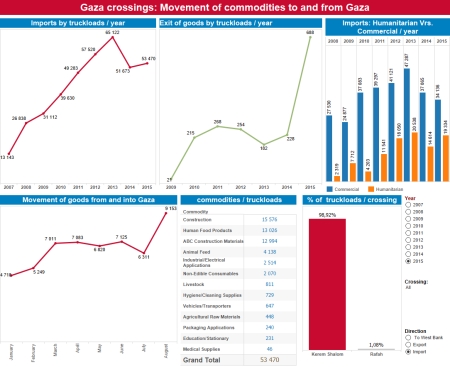
Egyptian military vehicles are transferring Mediterranean Sea water to the Rafah border, to fill a newly-built crude canal, flooding and destroying the lifeline tunnels connecting Egypt and blockaded Gaza. By canal the Egyptian government is trying to economically crush Hamas, an ally of the Muslim brotherhood. Egypt is planning that sea water will flood into any remaining undiscovered tunnels and completely destroy them. So called Gaza blockade or siege is one of the main causes or excuse – depending from viewpoint – for flotillas, BDS, EU’s labelling plans, anti-Semitism, donations to Hamas, humanitarian crisis etc. Given the facts referred above one could conclude that blaming Israel for blockade is at least unjust. More in Gaza Blockade – It’s Egypt not Israel!
The Israeli-Palestinian Conflict
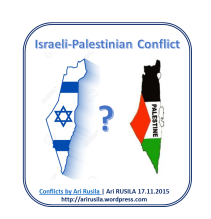 The Israeli-Palestinian peace process – or lack of that – is now at the crossroads. To start or not direct negotiations, between Israel and Palestinian Authority or at regional level, with or without preconditions, with or without facilitators, with 2-State solution as only aim or not, or would unilateral actions be the better option than keep the status quo. Is there Intifada-3 going on or not? A massive peace effort – the Madrid Conference and the Oslo Accords – ended the First Intifada; a massive military campaign – Operation Defensive Shield – ended the Second Intifada; how it will end the Intifada-3 if it really starts? These are some questions around the conflict. With this analysis I try to clarify main options to solve Israeli-Palestinian conflict in relation to current situation.
The Israeli-Palestinian peace process – or lack of that – is now at the crossroads. To start or not direct negotiations, between Israel and Palestinian Authority or at regional level, with or without preconditions, with or without facilitators, with 2-State solution as only aim or not, or would unilateral actions be the better option than keep the status quo. Is there Intifada-3 going on or not? A massive peace effort – the Madrid Conference and the Oslo Accords – ended the First Intifada; a massive military campaign – Operation Defensive Shield – ended the Second Intifada; how it will end the Intifada-3 if it really starts? These are some questions around the conflict. With this analysis I try to clarify main options to solve Israeli-Palestinian conflict in relation to current situation.
Sure also in my opinion a two-state solution might be possible. The final status agreement – negotiated compromise – has been very close at least since Beilin-Abu Mazen understandings / agreement / plan (1995) where nearly all issues were agreed. The Olmert proposal (2008) was probably the last serious try (both plans can be found from my document library ). These plans have been refined many times and serious work can be seen e.g. in leaked Palestine Papers/PaliLeaks (More in ”Pali-Leaks, land swaps and desperate search of peace” ). The endgame with 2-state solution will probably be according The Clinton Parameters . The key element with 2-State Solutions are negotiated borders based to pre-1967 armistice lines with land swaps; the state of Palestine as the homeland of the Palestinian people and the state of Israel as the homeland of the Jewish people; Palestinian sovereignty over the Temple Mount/Haram, and Israeli sovereignty over the Western Wall and the space sacred to Judaism; Palestine defined as a “demilitarized state”, solving the refugee question by giving limited return to Israel, return to the new State of Palestine or rehabilitation refugees in host country.
I have long been advocating Three State (return) Option – described also as no-state option – as the most pragmatic solution to Israeli-Palestinian conflict. In this 3-state scenario Amman rules the Cairo West Bank and Cairo runs Gaza. This scenario includes a Jordanian option meaning recognition and development of Jordan as the Palestinian State – Israel, the United States and the international community will recognize the Kingdom of Jordan as the only legitimate representative of the Palestinians. Jordan will once again recognize itself as the Palestinian nation-state.
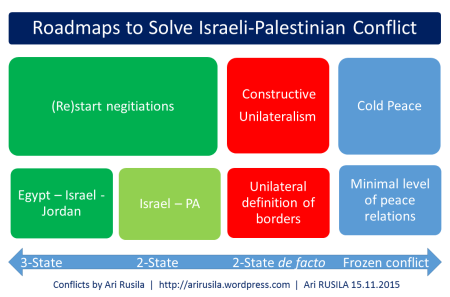
In my opinion there is three main pathways to solution of Israeli-Palestinian conflict and they are following:
- (Re)starting negotiations,
- Constructive unilateralism, and
- Cold Peace
More in Analysis: Resolving The Israeli-Palestinian Conflict
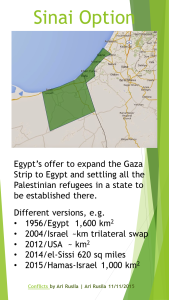 Palestinian Authority President Mahmoud Abbas was quoted on 9th November 2015 as claiming that Israel and Hamas have been conducting direct negotiations to expand the Gaza Strip so that it would include some 1,000 square kilometers of Sinai. Abbas, who was recently visiting in Cairo, told that the idea of slicing off land from Sinai to expand the Gaza Strip was first proposed by ousted Egyptian President Mohamed Morsi. In my opinion annexing part of Sinai to Gaza as might partly solve Arab-Israeli Conflict. In addition Hamas-Israel Deal could pave way for the ‘Cold Peace Solution’ and beyond. (More in Sinai Option again and Hamas and Israel on Verge of the Deal )
Palestinian Authority President Mahmoud Abbas was quoted on 9th November 2015 as claiming that Israel and Hamas have been conducting direct negotiations to expand the Gaza Strip so that it would include some 1,000 square kilometers of Sinai. Abbas, who was recently visiting in Cairo, told that the idea of slicing off land from Sinai to expand the Gaza Strip was first proposed by ousted Egyptian President Mohamed Morsi. In my opinion annexing part of Sinai to Gaza as might partly solve Arab-Israeli Conflict. In addition Hamas-Israel Deal could pave way for the ‘Cold Peace Solution’ and beyond. (More in Sinai Option again and Hamas and Israel on Verge of the Deal )
Throughout two decades of the Israeli-Palestinian “peace process,” direct negotiation has been perceived as the only paradigm that can lead to an agreement. But that paradigm has made direct negotiation as the goal in itself instead of the means to reach an agreement. Further, the failure to reach an agreement has given excuses to the rejectionists and extremists on both sides, allowing them to blame the other party for failure to progress, and destroying the belief within the respective societies that an agreement is possible in the foreseeable future.
From my perspective a new framework is needed, even if some apparent negotiations start the outcome probably will be a placebo to status quo. Two new leftist initiatives – ‘it’s in our hands’ by Omer Bar-Lev and ‘Constructive unilateralism’ by Blue White Future – are steps forward and in my opinion also to the right direction. might include required new roadmap for better future. In my article Constructive Unilateralism: Leftist Approach to Israel-Palestine Conflict I refer first to plan ‘it’s in our hands’ by Omer Bar-Lev, an MK for the Zionist Union. He concludes:
If Israel wants to be a democratic state, which it does, then it has to either grant them full citizenship rights, which will subsequently destroy Zionism (one state for two nations) or separate from the Palestinians (two states for two nations). In that case, Israel can keep the Zionist spirit. Then, it is for the Palestinians to decide to create their Palestinian State, which is in their interests and they will make their own decisions.
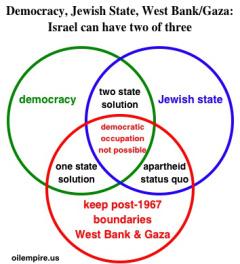
One provocative view to issue
The plan calls for Israel to unilaterally define its own borders to ensure its security, would keep control of all of Jerusalem and the Jordan Valley and bequeath about 60 percent of the West Bank to the Palestinians, evacuating 35,000 Jewish settlers — less than 10 percent of the total. This plan might be provocative but for me it seems to be realistic tactic towards two-state solution.
An Israeli NGO Blue White Future, a non-partisan political movement founded in 2009, has a bit similar idea. Blue White Future seeks to help resolve the Israeli-Palestinian conflict on the basis of a “two states for two peoples” solution by facilitating the relocation of settlers so that all Israel’s citizens reside within secure permanent borders that guarantee a Jewish majority. BWF proposes that the international community should adopt a paradigm that allows all stakeholders – Israel, Palestinians, the US and the other players – to take independent steps that will advance a reality of two states. Once the parameters are on the table, any independent step taken in the future can be clearly evaluated regarding whether they moves us closer to the reality of two states, and are thus considered constructive, or take parties further away.
If peace negotiations don’t start, they fail again or regional solutions can’t be realized this time so from my viewpoint Israel could independently implement what I have called a ‘Cold Peace Solution’, a minimal level of peace relations, where Israel would annex main settlements from West-bank inside the security fence and return to negotiations about other than so solved border issue when both parties feel need to make a long term deal. This solution in my opinion is the best way forward and it even might be possible to implement. If unilateral solutions are made in the framework of constructive unilateralism so this approach might be the right roadmap towards more permanent two-state solution. Not so bad option compared status quo anyway from my perspective.
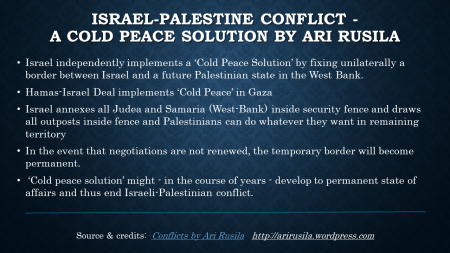
BDS, Coexistence and Anti-Semitism
When fragile Minsk II for Ukraine is ‘to be or not to be’ stage, while 21 Ethiopian Christians were beheaded in Libya and while hundreds of refugees drowned in the Mediterranean and while there the increasing chaos in the Maghreb region and in the Middle East with increasing refugee problem, when Palestinians are being brutally murdered by ISIL in refugee camps in Syria, so during these ongoing conflicts it might be difficult to decide about priorities of EU foreign policy. However EU Foreign ministers found an easy and cheap solution – their top priority is labelling Israeli products from the disputed territories (West Bank).
16 of the European Union’s (EU) 28 foreign ministers co-signed a letter to EU foreign policy chief Federica Mogherini, urging her to advance the creation of guidelines to separately label goods produced in the West Bank as part of an economic offensive on Israel. The labeling plan was first mooted in 2012, but the 16 member states told EU foreign affairs head Federica Mogherini it was now time to press ahead as part of efforts to force Israel to divide in a “two state solution.” When the whole MENA region risks falling into an abyss of war and genocide EU foreign ministers choose to attack the only stable democracy in the region, namely Israel. And this attack even does not help Palestinians as its effect might be totally opposite.
There are 15 industrial zones in territory Israel seized in the 1967 war. They have about 1,000 plants — sophisticated aluminum and food manufacturers as well as tiny textile and furniture workshops — that pump roughly $300 million into the Palestinian economy through salaries .One should note that the employment of Palestinians, including refugees, is one of the main problems that must be solved if the stability of the region is to be ensured. Instead of BDS foreign investment to West Bank and Gaza should be encouraged; restrictions on marketing West Bank and Gaza produce in Israel, Europe and the rest of world should be removed to create employment opportunities for the Palestinians. Beside salaries Israeli enterprises provide rare opportunities for coexistence between the two peoples. More in Top Priority of EU Foreign Policy: A New ‘Jude’ Badge
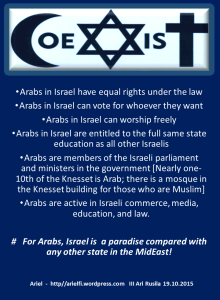 Following multiple, unexpected, terror attacks committed by mainstream Israeli-Arabs, some ethnic tensions are rising inside Israel. Some cities are distancing Israeli-Arabs from Jewish schoolchildren. The cities of Tel Aviv, Ness Tziona and Givatayim joined the list of Israeli cities which have decided to block Arab employees from entering schools during school hours, for security reasons. More in Coexistence Challenged In Israel
Following multiple, unexpected, terror attacks committed by mainstream Israeli-Arabs, some ethnic tensions are rising inside Israel. Some cities are distancing Israeli-Arabs from Jewish schoolchildren. The cities of Tel Aviv, Ness Tziona and Givatayim joined the list of Israeli cities which have decided to block Arab employees from entering schools during school hours, for security reasons. More in Coexistence Challenged In Israel
Beside ethnic tensions between Jews and Palestinians and political ones between Hamas and Fatah there is also some anger exists due corruption, nepotism and inequality inside West Bank Arabs. In communities throughout the Palestinian Authority in the West Bank, a surprising degree of luxury exists alongside the poverty. Some examples in Luxury Alongside Poverty in the Palestinian Authority by The Jerusalem Center, November 5, 2015

PSR poll December 2014
Palestinian Center for Policy and Survey Research (PSR) has published their quarterly research e.g. on levels of support for the two-state solution, (which is that support for the two-state solution has dropped to 51 per cent support in Israel and has stayed steady on 51 per cent support among Palestinians). However the really worrying results were related to fears of Israelis and Palestinians: As many as 56 per cent of Israelis are worried or very worried on a daily basis that they will be murdered by Arabs and 79 per cent of Palestinians are worried or very worried on a daily basis that they will be murdered or have their land confiscated by Jews. More in Israeli-Palestinian Fears . The fear s might lay ground for sc ‘Stabbing/Knife Intifada’ which terrorized Israel from late summer onwards.
From positive side Russian President Vladimir Putin continues his fight against anti-Semitism. At the initiative of President Putin, the Duma (Russian Parliament) has legislated a law outlawing “distorted and/or extremist” commentary of Scriptures. The purpose of the unusual law, it is widely understood, is the prevention of cynical advantage being taken of Biblical verses for anti-Semitic purposes. Recent meetings between Putin and Netanyahu, military co-ordination in the skies over Syria and closer economic ties appear to be strengthening the relations between the two countries. However the Russia’s fight against anti-Semitism will create real content to fair cooperation at grassroots too. More in Putin Against Anti-Semitism
Elections
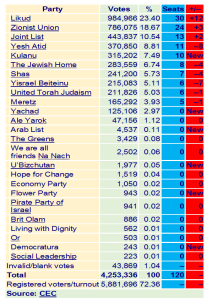 Israeli voters gave Prime Minister Benjamin Netanyahu a resounding victory in Tuesday’s [17th Mar. 2015] election, despite pre-election polls showing him trailing the Zionist Union. The results of Knesset 2015 were following:
Israeli voters gave Prime Minister Benjamin Netanyahu a resounding victory in Tuesday’s [17th Mar. 2015] election, despite pre-election polls showing him trailing the Zionist Union. The results of Knesset 2015 were following:
Related to peace process my forecast after elections was that if centre-right wing government continues after elections so nothing will change in peace process. The optimist side of me would like to compare situation now with situation ten years ago. Ariel Sharon was war hero know about his hawkish attitude and his position was strong. After this election PM Netanyahu has now a strong mandate and he could make similar brave decisions and broke deal with Palestinian Authority based two-state solution and -67 armistice line – with land swaps to annex main settlements behind security fence to Israel. Remains to be seen if this optimism will be Utopian – I hope not. More in Knesset 2015: Forecast and Knesset 2015: Post-Election Notes .
Other topics: Protective Edge, Susya and Iran
 During last Gaza conflict – on summer 2014 – I wrote about some peculiarities in then ongoing operation “Protective Edge” (Peculiarities of Operation Protective Edge ) on comparison to the earlier Gaza conflicts/wars. One of the main issues then and earlier has been discussion/debate/media-war related to civilian deaths during Israeli operations (e.g. Minimizing Collateral Damage In Gaza Conflict ).
During last Gaza conflict – on summer 2014 – I wrote about some peculiarities in then ongoing operation “Protective Edge” (Peculiarities of Operation Protective Edge ) on comparison to the earlier Gaza conflicts/wars. One of the main issues then and earlier has been discussion/debate/media-war related to civilian deaths during Israeli operations (e.g. Minimizing Collateral Damage In Gaza Conflict ).
After the conflict the discussion about civilian deaths and “war crimes” has continued. From its side Israel has made research about this (look e.g. Additional findings in the examination of the names of Palestinians killed in Operation Protective Edge – Part Eight ). Now Col. Richard Kemp, the former top UK commander in Afghanistan, submitted to UN investigators his views on Operation Protective Edge. In his excellent in-depth analysis on the last Gaza conflict Col. Kemp concludes e.g. following:
I believe Israel to be world leaders in actions to minimise civilian casualties; and this is borne out by the efforts made by the US Army, the most sophisticated and powerful in the world, to learn from the IDF on this issue. In my opinion Israel is also making strenuous efforts to investigate incidents where civilians were apparently unlawfully killed, wounded or ill-treated, and where civilian property was unlawfully damaged or stolen. I am not aware of any nation that has conducted more comprehensive or resolute investigations into its own military activities than Israel during and following the 2014 Gaza conflict.
More in Analysis: 2014 Gaza Conflict
To meet future challenges even better the Israel Defense Force (IDF) Chief of Staff Gadi Eizenkot published on 13th August 2015 a document outlining IDF strategy, including the threats facing Israel and plans to combat them. This is first time- in 60 years – since 1950s when Israeli PM David Ben-Gurion accepted military defense strategy of Israel. More in New Israel Military Strategy
Susya (Arabic: سوسية, Hebrew: סוּסְיָא) is the site of an ancient Jewish village in the southern Judaean Mountains south of Hevron, on the road towards Be’er Sheva, a Palestinian village claimed established by the 1830s and a religious communal Israeli settlement under the jurisdiction of Har Hebron Regional Council established in 1983. The Israeli Supreme Court has gave the green light for the demolition of 80 illegal structures in Arab Susya, which was built adjacent to the Jewish community of Susya that was established in 1983. Problematically, the Arab town was built on the archaeological site of ancient Susya, a Jewish village from the Temple Period.
The huge ongoing campaign against the demolition of buildings [mostly tents] constructed against a court order in Susya village was successful backed by some NGOs, US, EU and UN. From Western mainstream media one easily can get picture that Israel plans to destroy ancient Arab village in occupied territory and grabbing land owned by local villagers. The true picture is a bit different, even opposite. The archaeological evidence clearly proves that Jews lived in Biblical and Talmudic times until as late as the 9th century in Susya, while academic researchers have categorically established that Arabs never lived there.
More in Susya – Land-Grabbing By EU Backing and Demolition of Susya Settlement as a Result Unsolved Israeli-Palestinian Conflict
After 18 months of negotiating, Iran has come to a preliminary agreement – on 2nd Apr. 2015 – with China, Russia, France, UK, US and Germany (P5+1) on Tehran’s nuclear program. Niw the framework agreement is made but the negotiations for a final deal will continue through June 30th 2015. Israel opposes the terms of the framework agreement, because it allows Iran to retain some infrastructure that could be used for producing nuclear arms if Iran chooses to violate the framework’s terms. In recent months, this issue has clouded U.S.-Israel relations. If the latest Iran nuke deal will realize and even implemented I think it will be a win-win solution for most of stakeholders with the possible exception of Saudi Arabia. This said especially when asked what is the alternative? From my perspective all alternatives – war, air-strike to facilities or more sanctions – are worse. Iran has spread its nuclear facilities across the country and underground so airstrikes probably don’t delay Iran’s nuclear programme more than planned deal. To Iran agreement lets continue its research and gives it the benefits of nuclear energy as well the benefits of nuclear medical research and gives good change to develop Iran’s economy with wider international cooperation. More in Iran Nuke Deal And Israel
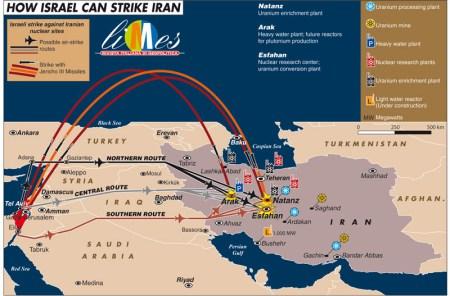
An other perspective to Israeli-Iranian relationship is presented in my article Israel-Iran Hostility Challenged At Grass Roots
From history
From history I published two articles: Netanyahu, Mufti and Holocaust and From History: “Beilin – Abu Mazen Plan” .
In October 20th 2015, Israeli Prime Minister Benjamin Netanyahu dropped a clanger in his speech to delegates at the 37th World Zionist Congress. According to Netanyahu, the Führer changed his mind at the insistence of the Palestinian Arab leader at the time, Haj Amin al-Husseini, who argued that the expulsion of the Jews would result in their arrival en masse to Palestine, which at the time was under British Mandatory rule; instead, according to Netanyahu, al-Husseini told Hitler to “burn them.” PM Netanyahu probably was overstating the Mufti’s role with ‘Final solution’. Article Netanyahu, Mufti and Holocaust gives background info about issue.
In 1993, under the direction of Yasser Arafat’s deputy, Abu Mazen (Mahmoud Abbas) held secret negotiations with Israel’s then–Deputy Foreign Minister, Yossi Beilin. The negotiations gave birth to the “Beilin–Abu Mazen Understandings,” (or Beilin-Abu Mazen plan or Beilin-Abu Mazen document) the first-ever draft of a final status agreement. Beilin and Abu Mazen managed to produce what seemed to be the first solid evidence that the Israeli-Palestinian conflict is soluble. They had drawn up Documents solemnly declaring that no serious problem stood in the way of a peace treaty with the Palestinians – not Jerusalem, nor Jewish settlements in the territories, nor the Palestinian demand for a right of return for their refugees. The document shows what the real back channel work can achieve.
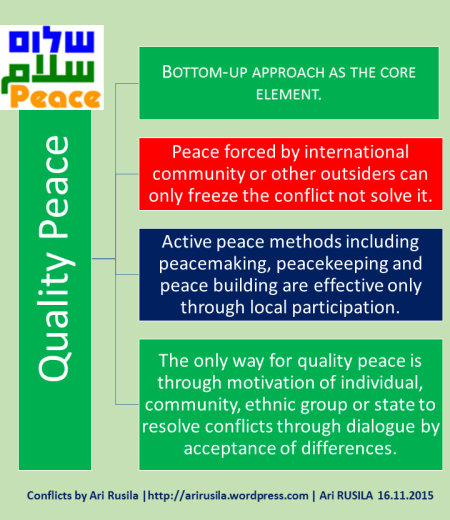
P.S:
My personal highlight: Sar-El 28.6.-17.7.2015
Israel 2015 articles (ENG) by Ari Rusila:
How Islamic State oil flows to Israel
Luxury Alongside Poverty in the Palestinian Authority by The Jerusalem Center, November 5, 2015
Analysis: Resolving The Israeli-Palestinian Conflict
War of Maps: Israel vs Palestine
Netanyahu, Mufti and Holocaust
10 deadly lies about Israel by Ron Dermer
Coexistence Challenged In Israel
Gaza Blockade – It’s Egypt not Israel!
Constructive Unilateralism: Leftist Approach to Israel-Palestine Conflict
Hamas and Israel on Verge of the Deal
Instead of Gaza’s Reconstruction Donor Aid Finances Terrorism And Corruption
Susya – Land-Grabbing By EU Backing
Demolition of Susya Settlement as a Result Unsolved Israeli-Palestinian Conflict
Israel-Iran Hostility Challenged At Grass Roots
What’s Going On In Gaza (And Mideast Peace)
Gaza State Under Construction, West Bank Remains Bystander
Top Priority of EU Foreign Policy: A New ‘Jude’ Badge
Knesset 2015: Post-Election Notes
From History: “Beilin – Abu Mazen Plan”
